Positive Health Online
Your Country

CranioSacral Therapy 21 years on
listed in craniosacral therapy, originally published in issue 13 - July 1996
Why are such a variety of healthcare practitioners excited about the tadpole-shaped bag that lines our skulls and spinal columns? The excited healthcare practitioners include massage therapists, doctors, nurses, osteopaths, dentists, physiotherapists, chiropractors, psychotherapists and – yes – vets. The tadpole-shaped bag is the dural membrane whose three layers surround, protect and connect our central nervous system, bathed and nourished in its own special liquid environment, cerebrospinal fluid.
The answer is that the insights, skill and determination of an American osteopathic physician led to a specialised and somewhat mysterious manipulative system that had been strictly reserved for osteopaths being developed and taught in ways that brought it safely within the scope of any healthcare professional with good intention and sensitivity of touch.
A new direction emerges
In the early 1970s Dr John E. Upledger discovered for himself, in a most tangible way, the cranio-sacral rhythm or cranial rhythmic impulse. This impulse was evident in causing a section of cervical dural tube, which he was attempting to stabilise during a delicate surgical procedure, to move with a frequency that was neither cardiac nor respiratory. Furthermore the rhythmic movement was so persistent as to prevent Dr Upledger from being able to keep the dural tube still. His curiosity aroused he went on to learn about the pioneering work of Dr W.G. Sutherland who formulated Cranial Osteopathy. Impressed by the effectiveness of Cranial Osteopathy, and following his 1975 appointment as a clinician researcher and Professor of Biomechanics at Michigan State University, Dr Upledger employed extensive research facilities to help understand how the phenomena that Dr Sutherland had discovered actually worked. This research began the formulation of CranioSacral Therapy. 21 years on, it has placed profoundly effective light-touch techniques in the hands of tens of thousands of practitioners.
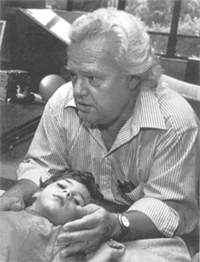
Dr John Upledger demonstrating technique
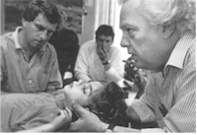
Dr Sutherland had been a pupil of A.T. Still, father of Osteopathy. Sutherland's cranial work was not only effective with various cases of pain that had failed to respond to osteopathic treatment, but was also helpful in restoring good metabolic function and assisting recovery from endogenous depression and respiratory disorders.
Despite Dr Sutherland's experiments including work with the human energy field and the use of very light touch, sometimes working off the body, Cranial Osteopathy was to develop very much as an extension of osteopathy, albeit with light contact, where the bones are seen as all important and the practitioner focuses on restoring to proper mobility the joints or sutures between the bones that make up the cranium. However, Dr Upledger's research and his consideration of how cranial suture restrictions tend to be maintained by structures outside the head caused him to deduce that it is within the body's membranes or fascia that the astonishing effects of Cranial Osteopathy are explained. It is interesting that A.T. Still also regarded the fascia as being of primary importance.
So now back to that tadpole-shaped envelope that contains the brain and spinal cord. Why is it so important? Apart from the obvious (that it contains and protects some rather vital equipment) it is from within this dural membrane that the cranio-sacral rhythm is generated. Also the dural membrane is centrally placed within the whole of the fascial system in such a way that it can influence, and be affected by, the condition of any and every other part of the body.
All-important membranes
The term fascia is the collective name for the membrane material that would remain were our hair, blood vessels, viscera, bones, nerves, muscle fibres and fluids to be removed. It includes our ligaments and all the membranous sheaths that surround and connect all our organs, bones and muscles. The tendency of restriction in one part of the body to transmit dysfunction to other parts is accounted for by the characteristics of fascial material and the construction of the whole fascial system. So fundamental are these aspects to a proper understanding of CranioSacral Therapy that they are worth going into in some detail.
First let's take a simplified look at the components of fascia. There are three basic components. Variations in their proportions account for the huge range of qualities and functions that fascia exhibit. They are collagen, a fibrous material that provides tensile strength, elastin which when tension is removed causes fascia to return to its original dimensions, thereby providing 'elastic memory', and ground substance which, as it were, fills in the spaces. Ground substance is wet and proteinous, and provides passage for dissolved nutrients and waste compounds. Fascia also contains sensory and motor nerves and has blood supply. It is capable of contraction. From the electrical perspective relaxed fascia carries negative electrical potential that supports healthy tissue metabolism. When under stretch the potential changes to positive. Fascia that is under continual tension will therefore suffer local metabolic deterioration and begin to lose some of its qualities.
Second we should consider the all-pervasive design of the fascial system. In the embryo, fascia forms from a single fold at a very early stage of development. Rather than being lots of different structures that have grown together, fascia is a single structure, holding together in functional relationship every part of the body. We can travel from any point on or in the body to any other without leaving fascia. In fact, it is so pervasive that it not only connects every cell but actually penetrates right into the nuclei, providing a framework for the chromosomes.
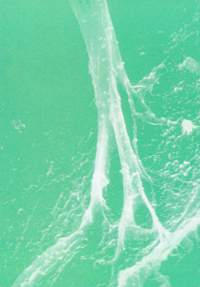
A collagen fibre branches as it enters a parasutral bone from the space of the sutre
where it is part of a fibrous web connecting with the other parietal bone
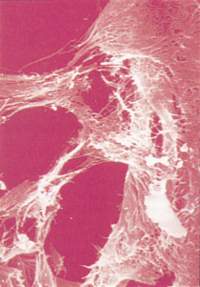
Cross section through a sutural blood vessel showing invasion
by the autonomic nerve plexus which served it
To summarise, fascia holds, connects, allows movement, helps the body remember what shape it's meant to be, contracts, feels, contains the body's fluids (blood, lymph and csf) and transmits load and strain throughout the body.
Weird connections
Now we can begin to understand the extraordinary effects of Dr Sutherland's work, how, for instance, the freeing up of the membranes inside the head by applying gentle pressure and/or traction to the cranial bones could lead to improved pituitary (and therefore endocrine) function, resolving many problems including hormone-related and metabolic illnesses. However, Dr Upledger found that many restrictions in the cranium often have causes outside the head. CranioSacral Therapy practitioners are used to the emergence of bizarre cause-and-effect connections: the appendicectomy scar that leads to chronic migraines, the compressed lumbo-sacral joint to endogenous depression, the restricted upper neck to digestive disorders or to hyperactivity, the unbalanced pelvis that may lead to eyesight problems.
Often the question is asked "What is CranioSacral Therapy useful for?" The straight, and perhaps rather unhelpful answer is "just about any health problem." But we want clear answers. "I have such-and-such a problem. What will fix it?" It is at this point that it helps to think clearly about how pain and illness really tend to occur. I find the most helpful starting point is to remember that we have our own self-healing mechanisms.
To the core of healing
As long as we are breathing, as long as our fluids are circulating, old structure is being demolished and removed while new material is being imported and built into new body parts. Our electrical and chemical systems are constantly informing each other of, and responding to, the latest developments and needs. In addition to these routine processes of renewal and repair there are exceptional items that need taking care of from time-to-time. Some of these exceptional items we will be aware of, like a minor cut or insect bite. Others will escape our attention provided we are healthy. One of the qualities of good health is the ability of our self-healing mechanism to take care of an endless list of minor insults and repairs without the need to divert our attention. Provided we don't overload our systems we have the flexibility to accommodate a whole variety of stressors. It is only when our system loses flexibility that we start running the risk of deteriorating health when problems that should be temporary tend to hang on or become chronic, or we may become very sensitive to substances or energetic influences that would not trouble a healthy person. (We call some of these sensitivities allergies.)
What sort of things happen to us that reduce our flexibility to renew and repair routinely? This is where the qualities and functions of the fascial system really start to account for themselves. Fascia has great flexibility and is fundamentally influential in all of our body processes. If fascia in one part of the body loses its flexibility due to mechanical inhibition or a toxic or malnourished environment it may affect any other part or system. Causes of mechanical inhibition include physical injury of any kind, surgery and occupational and postural strain. Injuries that can cause retained fascial restriction will include those that happen around birth. Other causes can be old or current inflammation, whether or not infection is or was involved. Inflammation tends to cause normally free-sliding fascial layers, such as the dural layers around the spinal cord, to bind together. With all of these causes resultant dysfunctions may not appear until years, sometimes decades, later.
The body tells its story . . .
So the CranioSacral Therapy practitioner is concerned about evaluating and helping to restore the flexibility of the whole fascial system. It is here that the cranio-sacral rhythm becomes a really useful tool. For while the skilled practitioner gains a fair impression of fascial mobility through light contact with the surface with the ability to project into deep tissue, working with the cranio-sacral rhythm brings greater accuracy in locating fascial restrictions. Evaluating the cranio-sacral rhythm also helps determine the involvement of the spinal nerves.
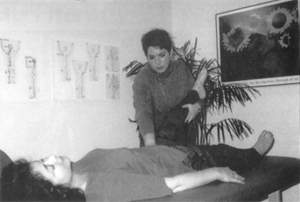
A practitioner giving treatment
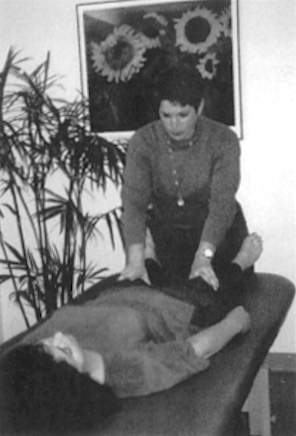
An extraordinary phenomenon that is the very essence of CranioSacral Therapy is the responsiveness of fascia to very subtle influences. Place hands very lightly on a clothed person lying supine on your treatment table and nothing may happen. Apply one or two grammes of pressure and all sorts of movements may start, where your hands are or anywhere else. Emotion may start to surface, and held-in emotion is yet another cause of reduced fascial flexibility. Even without a single gramme of imposed pressure or traction, the mere alteration of thought or attention can facilitate fascial movement. It is as if the attitude and intention of the practitioner create an atmosphere where the fascia (at last!) feels secure enough to risk the idea of starting to let go.
. . . and reveals its solutions
This is an appropriate point to consider further the idea that the elastic nature of fascia enables it to carry the memory or intelligence of exactly how the body would like to be arranged to enjoy the greatest ease. Fascia under tension is always trying to pull the body back to this state of greatest ease. One of Dr Upledger's great insights is that the body knows in full detail and with total accuracy exactly what it needs to do, and what assistance it needs, to return to this state of ease. The good CranioSacral Therapy practitioner learns to respect this fascial wisdom in preference to anyone's ability to diagnose and intervene from the outside. By listening and feeling the fascial wisdom expressing itself we are taken to the deeper causes of pain and dysfunction instead of being distracted and delayed by symptoms and their apparent causes.
The more helpful answer to the question "What is CranioSacral Therapy useful for?" would therefore be "Any condition where the self-healing mechanism can be supported through improved fascial flexibility", and that covers the majority of conditions that involve pain, restriction, lowered energy, increased susceptibility to infection, and poor circulation or breathing. CranioSacral Therapy also helps many people with specific learning difficulties such as dyslexia, dyscalclia and clumsiness, our co-ordination and proprioceptive mechanisms being easily upset by imbalance of the cranial fascia and bones. Early evaluation and treatment of newborns is recommended, as colic, feeding difficulties and hyperactivity will often be quickly and easily reduced or eliminated. Strains introduced before, during or shortly after the birth process can also be quickly and easily eliminated that may otherwise be retained through adulthood with consequences of chronic dysfunction that would take much more time and perseverance to release from a less fluid and flexible mature person.
Qualities for practice
The adoption of cranial work by healthcare practitioners other than osteopaths came about through two pieces of exploratory work which Dr Upledger led and supervised while a Professor of Biomechanics at the University of Michigan School of Osteopathic Medicine. The first was a clinical trial involving children who had brain function problems, within the Michigan public school system. Hundreds of such children would need evaluation to check if cranio-sacral problems were present and therefore if treatment by
Dr Upledger would be appropriate. Insufficient of the University medical staff were interested enough or available to train to do the evaluations but some lay helpers – special needs teachers, social workers, clinic staff, etc. were keen to get involved. So Dr Upledger evolved a format for breaking down the evaluative procedures into very simple components, without any loss of sensitivity. And in fact it was this approach to training that was to form the basis of the skills development programme that Dr Upledger has designed for training healthcare practitioners. In the event too many children were found to have cranio-sacral irregularities for Dr Upledger alone to handle, so he allowed his newly-trained colleagues to do some of the treatment. Furthermore, wishing treatment to be as continuous as possible he started teaching the more motivated parents to perform simple release techniques for daily use at home, with improved results.
Dr Upledger and some of his team then became involved with helping autistic children at a special centre. There he discovered that the prerequisites for progress in treatment were not so much medical qualifications as sensitivity of touch and good intention. Experienced CranioSacral Therapy practitioners find that more is achieved by waiting and listening than by trying to 'do' anything. However, it is also true that the more detailed understanding we have of the anatomy we are waiting with and listening to, the more productive our presence becomes. It is as if our intention becomes more informed.
Putting his work on paper for the benefit of students of cranial work resulted in the publication in 1983 of Dr Upledger's first book CranioSacral Therapy, which he co-authored with Jon Vreedevogd, one of his scientific collaborators at Michigan State University, whose speciality is the study of form in relation to function, or 'natural architecture'. CranioSacral Therapy is now recognised as required reading for serious students of the cranio-sacral system. Then followed CranioSacral Therapy II; Beyond the Dura and SomatoEmotional Release and Beyond, both under Dr Upledger's sole authorship. Most recently he has written a brief and inspiring introductory paperback Your Inner Physician and You which tells the story of his development of CranioSacral Therapy and SomatoEmotional Release – an approach to helping uncover, resolve and release deep emotional issues and their structural and functional components.
The word spreads
In 1985 Dr Upledger founded The Upledger Institute in Palm Beach, Florida. The Institute is a research and educational undertaking which incorporates a clinic offering a variety of naturopathic therapies. It provides training programmes based around intensive workshops throughout North America, the Pacific, Japan and Australasia. The Upledger Institute Europe was established in 1990. Based in Doorn in The Netherlands it provides training in continental Europe and Scandinavia. The Upledger Institute U.K. started operations in 1993 and serves the U.K. and Ireland. So far over 25,000 students have benefited from The Upledger Institute's training programmes.
One of the joys of introducing experienced healthcare practitioners to CranioSacral Therapy is to observe how students of very diverse backgrounds come to work together so quickly and with such ease through the 'middle ground' of the fascia. Osteopath, massage therapist, physiotherapist, acupuncturist and psychotherapist blending together, to me corresponds with the fascia allowing the body's rigid structures to interrelate with its liquids and gases.
Dr Sutherland started teaching Cranial Osteopathy in 1940. Notwithstanding the distinction between Cranial Osteopathy and CranioSacral Therapy, in the reality of everyday practice the distinctions have become blurred as more and more practitioners are drawn into the fascial system in pursuit of the needs of the whole person. It really does seem as if the fascia are holding the centre ground. On the one hand the more structural practitioners who like to focus on the neuromusculo- skeletal system may care to remember, as A.T. Still did, that the fascia hold it all together. And on the other hand those who have more of an affinity for fluids and energy would I am sure agree that fluids need containers and pipes if they are to be useful. Likewise energy needs storage places and pathways. The condition of those containers, pipes and pathways has, as any plumber, electrician or acupuncturist knows, a profound influence. The fascia provide all of these.
International network
The Upledger Institute provides referral services for those seeking a CranioSacral Therapy practitioner, as well as programmes of training for practitioners. Designed to be adaptable to an individual's own learning needs, the Institute's intensive training workshops are held in a variety of locations and supported by detailed study guides and sourcing of textbooks, research articles and other learning materials. Many students pursue their Upledger training in more than one country, and all have access to the resources of the headquarters in Palm Beach, Florida. The Upledger Institute also runs clinical symposia and research conferences.
U.K. and Ireland contact: The Upledger Institute U.K., 52, Main Street, Perth, PH2 7HB, Scotland. Telephone (01738) 444404, Fax (01738) 442275.
Comments:
-
No Article Comments available